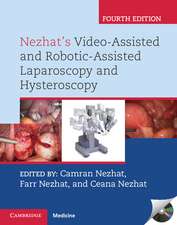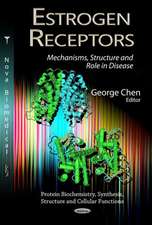Anxiety Disorders: Pathophysiology and Pharmacological Treatment
Autor Gerard Emilien, Cecile Durlach, Ulla Lepola, Timothy Dinanen Limba Engleză Paperback – 5 noi 2012
| Toate formatele și edițiile | Preț | Express |
|---|---|---|
| Paperback (1) | 721.77 lei 6-8 săpt. | |
| Birkhäuser Basel – 5 noi 2012 | 721.77 lei 6-8 săpt. | |
| Hardback (1) | 730.34 lei 6-8 săpt. | |
| Birkhäuser Basel – mar 2002 | 730.34 lei 6-8 săpt. |
Preț: 721.77 lei
Preț vechi: 759.76 lei
-5% Nou
Puncte Express: 1083
Preț estimativ în valută:
138.12€ • 143.33$ • 115.45£
138.12€ • 143.33$ • 115.45£
Carte tipărită la comandă
Livrare economică 18 martie-01 aprilie
Preluare comenzi: 021 569.72.76
Specificații
ISBN-13: 9783034894609
ISBN-10: 3034894600
Pagini: 324
Ilustrații: XIX, 298 p.
Dimensiuni: 178 x 254 x 17 mm
Greutate: 0.57 kg
Ediția:Softcover reprint of the original 1st ed. 2002
Editura: Birkhäuser Basel
Colecția Birkhäuser
Locul publicării:Basel, Switzerland
ISBN-10: 3034894600
Pagini: 324
Ilustrații: XIX, 298 p.
Dimensiuni: 178 x 254 x 17 mm
Greutate: 0.57 kg
Ediția:Softcover reprint of the original 1st ed. 2002
Editura: Birkhäuser Basel
Colecția Birkhäuser
Locul publicării:Basel, Switzerland
Public țintă
ResearchCuprins
1:Normal and pathological anxiety.- 1 What is anxiety?.- 2 Relevance of laboratory research on anxiety disorders.- 3 Genetic factors and brain imaging.- 4 Management.- 5 Discussion.- 2:Biological basis of anxiety and strategies for pharmacological innovation.- 1 Introduction.- 2 Neurobiology of anxiety disorders.- 3 Recent development and future anxiolytics.- 4 Discussion.- 3:Generalised anxiety disorder.- 1 Introduction.- 2 Diagnostic.- 3 The phenomenon of worry.- 4 Neurobiology.- 5 Physiopathology.- 6 Epidemiology and natural course.- 7 Treatment.- 8 Methodology for clinical investigation.- 9 Discussion.- 4:Social phobia.- 1 Introduction.- 2 Diagnosis and comorbidity.- 3 Pathophysiology.- 4 Treatments.- 5 Methodology of clinical investigations.- 6 Discussion.- 5:Panic disorder.- 1 Introduction.- 2 Diagnosis and aetiology.- 3 Pathophysiology.- 4 Treatments.- 5 Methodology for clinical investigation.- 6 Discussion.- 6:Obsessive-compulsive disorder.- 1 Introduction.- 2 Diagnostic.- 3 Physiopathology.- 4 Treatment.- 5 Methodology for clinical investigation.- 6 Discussion.- 7:Posttraumatic stress disorder.- 1 Introduction.- 2 Epidemiology.- 3 Comorbidity.- 4 Physiological and neurological abnormalities associated with PTSD.- 5 Cognitive dysfunction associated with PTSD.- 6 Treatment of PTSD.- 7 Discussion.- 8:Phobic disorders.- 1 Introduction.- 2 Epidemiology.- 3 Genetics.- 4 Treatment.- 5 Discussion.- 9:Laboratory models of anxiety.- 1 Introduction.- 2 Biological animal models.- 3 Behavioural animal models.- 4 Human models.- 5 Issues relevant to some non-benzodiazepine anxiolytics.- 6 Discussion.- 10:Discussion and perspectives.- Future perspectives.
Textul de pe ultima copertă
Anxiety disorders are very common and constitute some of the most frequent psychological problems in medical practice. The term anxiety disorder is used to describe conditions in which pathologic anxiety is the predominant factor. These conditions include phobic disorders, panic disorder, generalized anxiety disorder, posttraumatic stress disorder and obsessive-compulsive disorder.
Management of anxiety disorders may involve physical treatments such as drugs, psychological treatments such as psychotherapy or behavioural cognitive therapy or a combination of both. The development of new drugs with improved safety and tolerability is an important step in the treatment of anxiety.
In this book, the discussion of the normal and pathological aspects of anxiety is critically examined. Particular attention is given to aetiology, differential diagnosis, epidemiology and both cognitive and pharmacological treatments. The book covers most aspects of anxiety disorders which makes it useful for a wide range of clinicians as well as researchers, e.g. psychiatrists, general practitioners, pharmacologists etc.
Management of anxiety disorders may involve physical treatments such as drugs, psychological treatments such as psychotherapy or behavioural cognitive therapy or a combination of both. The development of new drugs with improved safety and tolerability is an important step in the treatment of anxiety.
In this book, the discussion of the normal and pathological aspects of anxiety is critically examined. Particular attention is given to aetiology, differential diagnosis, epidemiology and both cognitive and pharmacological treatments. The book covers most aspects of anxiety disorders which makes it useful for a wide range of clinicians as well as researchers, e.g. psychiatrists, general practitioners, pharmacologists etc.










